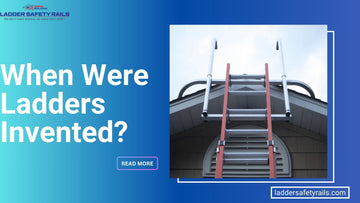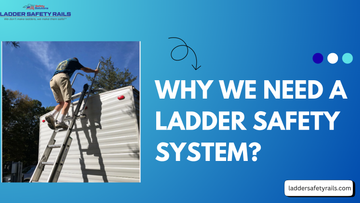
With hundreds of injuries occurring daily, and a quarter of these resulting from falling from the ladder due to improper ladder set up. The one thing that you would need now to avoid it is the right ratio for setting up an extension ladder.
Understanding how to position your ladder correctly can significantly reduce the risk of injury. In this blog, we will explore the right ratio for setting up an extension ladder, specifically focusing on the important 4 to 1 ratio for optimal safety and stability.
Why Proper Ladder Setup Matters?
Before climbing any ladder, ensuring it’s set up properly is crucial. A poorly positioned ladder can easily slip or tip, causing dangerous falls. This is especially true when working with extension ladders, which are often used to reach high, difficult-to-access places. According to OSHA guidelines, a ladder’s setup is just as important as choosing the right type for the job.
When you set up an extension ladder, one of the most critical steps is following the 4 to 1 ratio. This simple 4 1 rule helps to ensure the ladder is placed at the correct angle, reducing the chances of it tipping backward or slipping away from the structure.
What is the ratio for setting up an extension ladder?
It’s the 4 to 1 rule, meaning for every four feet of ladder height, the base of the ladder should be one foot away from the wall or structure it’s leaning against. This provides the right ladder angle to keep the ladder stable while you work.
The 4 to 1 Ratio for Extension Ladders
The 4 1 rule is a safety guideline that every ladder user should follow. For every four feet of height the ladder reaches, the base of the ladder should be placed one foot away from the wall or structure it’s leaning against.
For example, if the top of your extension ladder reaches 20 feet, the base should be positioned five feet away from the structure. This 4 1 ladder ratio keeps the ladder at a safe, stable angle that minimizes the risk of falls.

How to Use the 4 1 Ladder Ratio:
- Position the Ladder: Place your ladder with the top against the wall or structure.
- Face the Ladder: Stand facing the base of the ladder, with your toes touching it.
- Raise Your Arms: Lift your arms to shoulder height. If you can reach the ladder’s rungs easily without needing to adjust the ladder, the base is at the right distance.
By following this simple method, you can ensure that your ladder is positioned properly and securely for climbing.
Why the 4-1 Ladder Rule is Important
The 4-1 ladder rule is essential for maintaining balance and stability when using an extension ladder. If the ladder is positioned too steep or too shallow, it increases the risk of tipping. A properly angled ladder, set up according to the 4 to 1 rule, ensures it stays stable and secure, even while you’re climbing or working from the top.
By adhering to this ratio, you’re making sure the ladder is positioned in a way that allows you to safely ascend and descend.
Common Mistakes to Avoid When Setting Up a Ladder
Even with the 4 to 1 rule, overlooking key safety details can lead to accidents. Such as:

- Placing the ladder on uneven or unstable ground. Always ensure the base is on a firm, level surface to prevent tipping.
- Setting the ladder at the wrong angle—too steep or too shallow—which compromises its stability.
- Overreaching while on the ladder is also a significant risk. Always keep your body centered between the side rails and move the ladder as needed instead of stretching too far.
- Using a damaged or unsuitable ladder for the task. Inspect the ladder for cracks, bent rungs, or other issues before use.
By being mindful of these errors and taking simple precautions, you can ensure your ladder setup is safe and reliable every time. Remember, safety starts with preparation!
Final Thoughts:
Setting up an extension ladder may seem straightforward, but it’s essential to follow the right procedures to avoid accidents. The 4 to 1 ladder rule helps ensure that your ladder is stable and safe to use. Always check the ladder’s condition, ensure it’s placed on stable ground, and follow this simple rule to keep your work environment as safe as possible.
Remember, extension ladder safety starts with proper setup and maintenance. However, a little precaution can save you from that one accident. Hence, for additional safety, you should check out the Ladder Stabilizer for Roof and HandRail System from Ladder Safety Rails. Ladder stabilizer helps to keep your ladder stable and in position while you do your work. And in case you want to learn more about ladder safety, check out our blogs section.

FAQs
-
What is the 4 to 1 ladder rule?
The 4 to 1 ladder rule means for every four feet of height, the base of the ladder should be placed one foot away from the wall or structure.
-
What ratio should a ladder be placed at?
Ladders should be set up using the 4 to 1 ratio. For every four feet of ladder height, the base should be one foot away from the wall.
-
What is the proper ratio when raising an extension ladder?
The proper ratio is the 4 1 ladder ratio, ensuring that the ladder is set at a safe angle and remains stable while in use.
-
Can i use a 4 1 balun with ladder line?
Yes, a 4:1 current balun can work with ladder line, especially in balanced antenna systems, to match impedance effectively.
-
What is the ratio for setting up an extension ladder?
The proper ratio is 4 to 1—1 foot away from the wall for every 4 feet of ladder height. This ensures the ladder stays stable and secure.
Read More Blogs Here:






